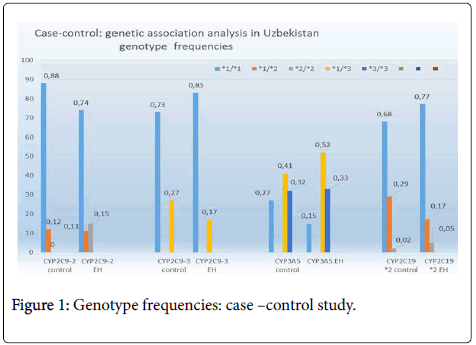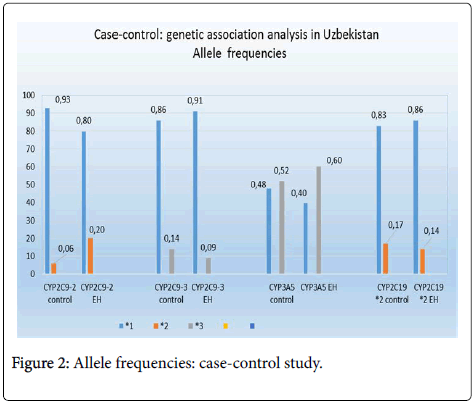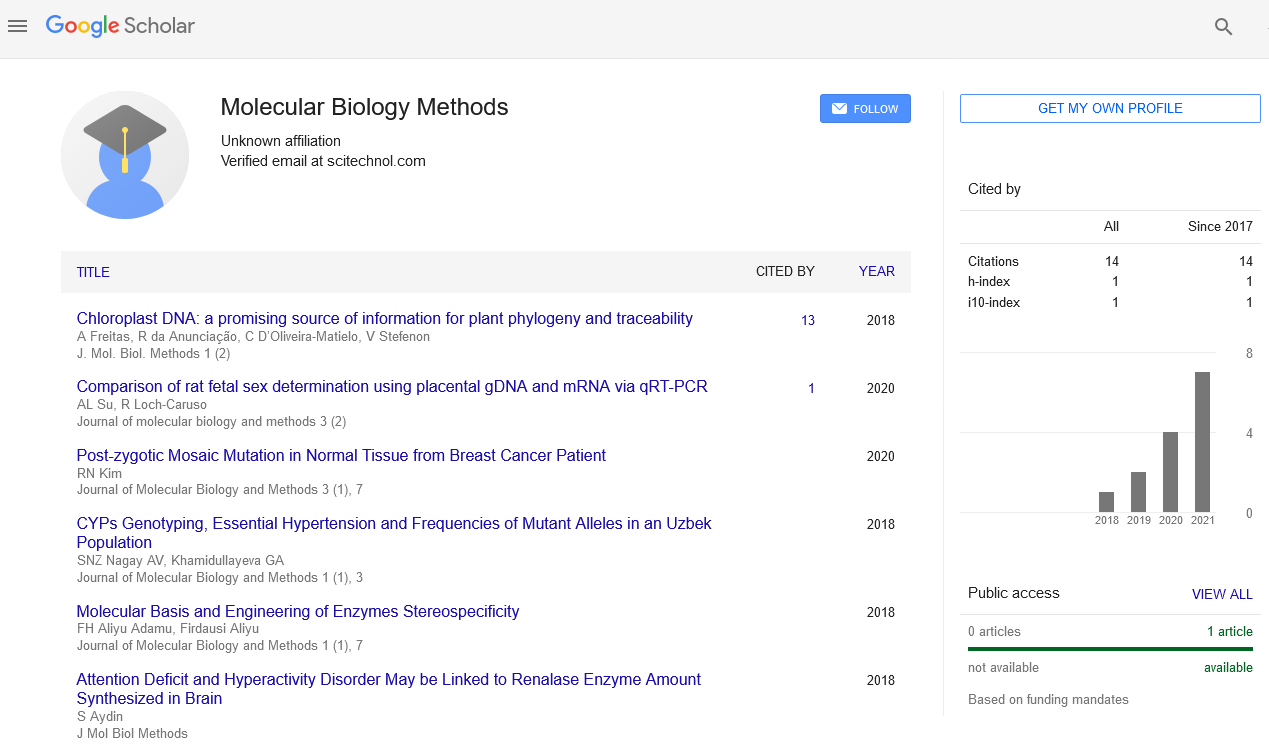Research Article, J Mol Biol Methods Vol: 1 Issue: 1
CYPs Genotyping, Essential Hypertension and Frequencies of Mutant Alleles in an Uzbek Population
Nagay AV*, Khamidullayeva GA, Srojidinova NZ and Kurbanov RD
Department of Arterial Hypertension and Molecular Genetics Research, Republican specialized medical center of cardiology, Tashkent, Uzbekistan
*Corresponding author : Nagay AV
Department of Arterial Hypertension and Molecular Genetics Research, Republican specialized medical center of cardiology, Tashkent, Uzbekistan
Tel: +998903503409
E-mail: alexsan1984@mail.ru
Received: May 29, 2018 Accepted: June 14, 2018 Published: June 24, 2018
Citation: Nagay AV, Khamidullayeva GA, Srojidinova NZ, Kurbanov RD (2018) CYPs Genotyping, Essential Hypertension and Frequencies of Mutant Alleles in an Uzbek Population. J Mol Biol Methods 1:1.
Abstract
Background and Objectives: Each patient has a combination of the genes bound to cardiovascular illnesses. The aim of our study was to determine the features of the distribution of genes associated with hypertension. In this paper we have described the 4 polymorphic loci distinctive susceptibility to hypertension. There are 4 polymorphisms of genes in nuclear DNA (CYP2C19 *2 CYP3A5, CYP2C9-3 and CYP2C9-2).
Materials and Methods: The study included 109 Uzbek men (mean age 48 ± 11 years) with untreated EH of stage 1-2 and 82 normotensive males.
Results: Distribution of allele frequency of, CYP2C19 *2 CYP3A5, CYP2C9-3 and CYP2C9-2 genes was similar with Saudi Arabian, Afro-American, Spain and European American population respectively. Registration of the genotyping results has identified an association CYPs gene (CYP2C9-2; CYP3A5) with the risk of EH. The CYP2C9-*2 allele showed a higher association with hypertension in comparison to the *1 allele (OR 3.89, 95% CI 0.48-10.20). In the analysis of cytochrome P450 in patients with EH, we have identified two common point of nucleotide substitutions (*2,*3). We have determined that monogenic Western and hybrid Eastern population of Uzbekistan are often carriers of damaging *2/*2 -genotype of CYP2C9-2 and *1/*3-*3/*3 genotype of CYP3A5 gene. Distribution of allele frequency was the most closely with American.
Conclusion: In the present study, we investigated the association between genotype variants of the CYPs genes and EH in Uzbek population. We found that the *2/*2 polymorphism of the CYP2C9-2 gene was associated with EH in Uzbek hypertensive patients. A separate analysis of case-control studies (CYP2C9-3: CYP2C19*2 genes) from Uzbekistan showed no significant differences in allele and genotype frequencies between hypertensive patients and normotensive control subjects. According to our opinion, the results are only preliminary and further large case-control studies in our and other Central Asia populations are needed to confirm this association.
Keywords: Essential hypertension EH; CYPs genes; Central Asia
Introduction
Each patient has a combination of the genes bound to cardiovascular illnesses [1]. About 20 years ago it was discovered by ward et al that 60% of population variability of blood pressure can be genetically determined. However, most studies have been performed on European population [2]. It is still unknown to what extent the data in European populations may be applicable to other ethnic groups. Despite a number of major studies on genome-wide association and blood pressure (HyperGEN, PRIDEMED) it was found that these studies account for only 3% of the inter-individual variability in blood pressure (International Consortium for BP GWAS).
For the last 25 years, the population of Uzbekistan was enlarged twice. Today such tendency of population increase is followed by its aging. The positive aspect of this phenomenon is augmentation of average life expectancy. However, a negative side that the augmentation of life expectancy doesn't correspond to its quality. Deterioration first of all is bound to augmentation of prevalence of age chronic diseases, such as a hypertension. For example, today in Uzbekistan, one of three adults has raised by the ABP, and excess weight occurs at every second (WHO/STEPS 2014). As a result it caused double increasing of visits of the doctor and total number of patients in general.
Genetic polymorphisms of CYPs among different populations in different geographical regions could be different. CYP2C9 is one of the major drug-metabolizing enzymes in humans. It has been shown to be polymorphic. The human CYP2C9 gene is located on chromosome 10 with a length of approximately 55 kb [3]. CYP2C9 is a major enzyme that belongs to the CYP2C subfamily. It constitutes about 20% of the hepatic cytochrome P450 enzyme expressed in humans and thus is responsible for the metabolism of a wide spectrum of clinically important drugs. The cytochrome P450 CYP3A5 subfamily plays a major role in the oxidative, peroxidative, and reductive biotransformation reactions of 50-60% of all currently used drugs exogenous carcinogens, and endogenous substrates such as steroids [4]. Genetic variation in a gene coding for a drug-metabolism enzyme can cause enzyme variants with high or no activity. Among these, CYP2C19*2 exhibit genetic polymorphism. Thereby population can be divided into phenotypes of poor metabolizers, extensive metabolizers and ultra-rapid metabolizers.
Materials and Methods
The study included 109 Uzbek men (mean age 48 ± 11 years) with untreated EH of stage 1-2 and 82 normotensive males. Genomic DNA was extracted from whole-blood leukocytes using a commercially available kit (Diatom DNA Prep 200 RF).
CYP2C9*2/ PCR-RFLP
Genotyping of the SNP was performed by polymerase chain reaction and restriction fragment length polymorphism PCR-RFLP. Sense primer was F-5´-ATCCACATGGCTGCCCAGTGTCA-3´. Reverse primer was R-5´-CACATGAGCTAACAACCAGACTCA-3´. The PCR primer was synthesized by EVROGEN Corporation. The conditions of amplification reaction were as follow: 95ºC for 5 min (initial denaturation); 94ºC for 30 s (denaturation); 56ºC for 30 s (annealing); 72ºC for 30 s (extension); 35 cycles; 72ºC for 7 min (extension); 4ºC (conservation). Five mL of PCR products were added in 3% agarose gel and then conducted to a horizontal electrophoresis for 40 min under a condition of 100 V constant voltages. Enzyme reaction system: a total volume of materials was 25 mL within 10 mL PCR products, 2.5 mL 10. buffer solution, 0.2 IU restriction endonuclease BmE 18I and 12.3 mL sterilization deionized water. Reaction condition: a warm bath (37ºC) for 16 h was designed. The digests were then subjected to electrophoresis on a 3% agarose gel and visualized under ultraviolet illumination, where the undigested product *1/*1- genotype showed a band of 173 bp, *1/*2- genotype showed a bands of 173 and 349 bp, and *2/*2- genotype showed a band of 349 bp.
CYP2C9*3/ PCR-RFLP
Genotyping of the SNP was performed by polymerase chain reaction and restriction fragment length polymorphism PCR-RFLP. Sense primer was F-5´-TGCACGAGGTCCAGAGGTAC-3´. Reverse primer was R-5´-ÐÂÂÂСÐÂÂÂÐÂÂÂÐÂÂÂСТTACCTTGGGAATGAGA-3´. The conditions of amplification reaction were as follow: 95ºC for 5 min (initial denaturation); 94ºC for 30 s; 56ºC for 30 s; 72ºC for 30 s; 35 cycles; 72ºC for 7 min (extension); 4ºC (conservation). Enzyme reaction system: a total volume of materials was 25 mL within 10 mL PCR products, 2.5 mL 10. buffer solution, 0.2 IU restriction endonuclease Kpnl and 12.3 mL sterilization deionized water. Reaction condition: a warm bath (37ºC) for 16 h was designed (3.5% agarose).
CYP3A5/ PCR-RFLP
Sense primer was F- 5´-CCTGCCTTCAATTTTCACT-3´. Reverse primer was R-5´-TATCACTTT CCATAAAAGCAA G-3´. The conditions of amplification reaction were as follow: 95ºC for 5 min (initial denaturation); 94ºC for 1 min (denaturation); 61ºC for 1min (annealing); 70ºC for 1 min (extension); 35 cycles; 72ºC for 7 min (extension); 4ºC (conservation). Reaction condition: a warm bath (RsaI -37ºC) for 16 h was designed. The digests were then subjected to electrophoresis on a 2.5% agarose gel and visualized under ultraviolet illumination, where the undigested product *1/*3- genotype showed a bands of 102, 94, 74, 20 bp, *1/*1- genotype showed a bands of 102, 74, 20 bp, and (*3/*3- genotype) showed a bands of 102, 94 bp.
CYP2C19*2/ PCR-RFLP
Sense primer was F-5´-AATTACAACCAGAGCTTGGC-3. Reverse primer was R-5´-GGTCCAAACAGGGAAGAGGT-3´. The conditions of amplification reaction were as follow: 94ºC for 5 min (initial denaturation); 94ºC for 45 s; 53ºC for 40 s; 72ºC for 30 s; 35 cycles; 72ºC for 5 min (extension); 4ºC (conservation). Reaction condition: a warm bath (SmaI -25ºC) for 16 h was designed. The digests were then subjected to electrophoresis on a 3% agarose gel and visualized under ultraviolet illumination, where the undigested product *1/*1- genotype showed a bands of 120, 49 bp, *1/*2- genotype showed a bands of 169, 120, 49 bp, and (*2*2- genotype) showed a band of 149 bp.
Statistical analyses
Associations between alleles and EH were sought using odds ratios (OR) with 95% confidence intervals. The significance level for all the analyses was set at p<0.05. Statistical analyses were performed using GenePop and Statistica v6.0 software (StatSoft, USA).
Results
CYP2C19 *2: The frequencies of the *1/*1, *1/*2, and *2/*2 genotypes were 0.77, 0.17, and 0.05 in hypertensive men, and 0.68, 0.29, and 0.02 in healthy men, respectively (p<0.05). The frequencies of the *1 and *2 alleles were 0.86 and 0.14 in the hypertensive group, and 0.83 and 0.17 in the control group, respectively (p<0.05). A similar pattern was observed in Saudi Arabian and Iranian populations as shown in Figure 1 and Figure 2 [5].
CYP2C9-2: 16 individuals (16-patients: 0-healthy) carried two mutated allele being homozygous for CYP2C9-2, thus could be classified as poor metabolizes, while 22 subjects (12-pations: 10- healthy) carried one mutated allele. The *2 allele showed a higher association with hypertension in comparison to the *1 allele (OR 3.89, 95% CI 0.48-10.20). The frequency of *2-allele of CYP2C9-2 gene was closely with American population [6].
CYP2C9-3: The frequencies of the *1/*1, *1/*3, and *3/*3 genotypes were 0.83, 0.17, and 0 in hypertensive men, and 0.73, 0.27, and 0 in healthy men, respectively (Table 1). The frequencies of the *1 and *3 alleles were 0.91 and 0.09 in the hypertensive group, and 0.86 and 0.14 in the control group, respectively (p<0.05). Distribution of genotype frequency was closely with Spain population [7].
| Uzbekistan CYP2C19*2 mt*2 | Saudi Arabian | Iranian | European American | Japanese |
|---|---|---|---|---|
| 0,17 | 0,15 | 0,14 | 0,13 | 0,23 |
| Uzbekistan CYP3A5 mt*3 | Afro-Americans | India | Chinese | Turkish |
| 0,52 | 0,47 | 0,59 | 0,75 | 0,07 |
| Uzbekistan CYP2C9*3 mt*3 | Spanish | India | Chinese | British |
| 0,14 | 0,12 | 0,18 | 0,07 | 0,05 |
| Uzbekistan CYP2C9*2 mt*2 | European American | India | British | Spanish |
| 0,06 | 0,08 | 0,04 | 0,1 | 0,22 |
Table 1: Distribution of CYPs variant among different ethnic groups.
CYP3A5: The frequencies of the *1/*1, *1/*3, and *3/*3 genotypes were 0.15, 0.52, and 0.33 in hypertensive men, and 0.27, 0.41, and 0.32 in healthy men, respectively (p<0.05). The frequencies of the *1 and *3 alleles were 0.40 and 0.60 in the hypertensive group, and 0.48 and 0.52 in the control group, respectively (OR 1.31, 95% CI 0.78-2.19). Distribution of allele frequency of CYP3A5 gene was similar with Afro-American population and UK [8].
Discussion
We have studied genotype of 4 gene of cardiovascular continuum and identified two diagnostically significant genes (CYP2C9-2 and CYP3A5 genes). Distribution of allele frequency of, CYP2C19*2 CYP3A5, CYP2C9-3 and CYP2C9-2 genes was similar with Saudi Arabian, Afro-American, Spain and European American population respectively [9]. Registration of the genotyping results has identified association of CYPs genes (CYP2C9-2; CYP3A5 ) with the risk of EH. In the analysis of cytochrome P450 in patients with EH, we have identified two common point of nucleotide substitutions (*2, *3). We have determined that monogenic Western and hybrid Eastern population of Uzbekistan are often carriers of damaging *2/*2 - genotype of CYP2C9-2 and *1/*3-*3/*3 genotype of CYP3A5 gene. Distribution of allele frequency was the most closely with American. Our study has several limitations. The number of patients and controls were limited for the research. Another limitation was that the healthy men were included as controls only for comparison of genotype and allele frequencies of the CYPs genes. Nonetheless, this is the first report examining the relationship between the *2/*2 polymorphism of the CYP2C9-2 gene and EH in Uzbek population. According to our opinion, our results are only preliminary and further large case-control studies in our and other Central Asia populations are needed to confirm this association.
Conclusion
In the present study, we investigated the association between genotype variants of the CYPs genes and EH in Uzbek population. We found that the *2/*2 polymorphism of the CYP2C9-2 gene was associated with EH in Uzbek hypertensive patients. A separate analysis of case-control studies (CYP2C9-3: CYP2C19*2 genes) from Uzbekistan showed no significant differences in allele and genotype frequencies between hypertensive patients and normotensive control subjects.
Acknowledgments
We wish to thank the director, physicians, and nurses from the Republican specialized center of cardiology hospitals for their assistance in blood collection. We also thank Prof. Marietta R Eliseyeva for the scientific contributions (IJBM International medical research & Development Corporation USA).
Financial and Competing Interest’s Disclosure: The authors have no other relevant affiliations or financial involvement in any organization or no financial interest in or financial conflict with the subject matter or materials discussed in the manuscript.
Protection of subjects: The medical information gathered during the study was treated confidentially except as may be required by the law. The study was approved by the medical ethical committee of the center of cardiology, Tashkent Uzbekistan.
References
- Levy D, Ehret G, Rice K, Verwoert GC, Launer LJ, et al. (2009) Genome-wide association study of blood pressure and hypertension. Nat Genet 41: 677-687.
- Walter S, Atzmon G, Demerath E, Garcia ME, Kaplan RC, et al. (2011) A genome-wide association study of aging. Neurobiol Aging 32: 2109.e15-28.
- Lee C, Goldstein J, Pieper J (2002) Cytochrome P450 2C9 polymorphisms: a comprehensive review of the in-vitro and human data. Pharmacogenetics 12: 251-263.
- Gibson G, Plant N, Swales K, Ayrton A, Sankary W (2002) Receptor dependent transcriptional activation of cytochrome P4503A genes: induction mechanisms, species differences and interindividual variation in man. Xenobiotica 32: 165-206.
- Negin Z, Nader T, Mahmood H, Alireza S, Iraj M (2006) Allele frequency of CYP2C19 gene polymorphisms in a healthy Iranian population. IJPT 4: 124-127.
- Goldstein JA, Ishizaki T, Chiba K, de Morais SM, Bell D, et al. (1997) Frequencies of the defective alleles responsible for the mephenytoin poor metobolizer phenotype in various Oriental, Caucasian, Saudi Arabian and American black population. Pharmacogenetics 7: 59-64.
- Dorado P, Berecz R, Norbeto MJ, Yasar U, Dahl ML, et al. (2003) CYP2C9 genotypes and diclofenac metabolism in Spanish healthy volunteers. Eur J Clin Pharmacol 59: 221-225.
- Barry K, Julian L, Elaine M, Faith M, Daly AK (2003) CYP3A5 phenotype-genotype correlations in a British population. Br J Clin Pharmaco 55: 625-629.
- Xie HG, Prasad HC, Kim RB, Stein CM (2002) CYP2C9 allelic variants: ethnic distribution and functional Significance. Adv Drug Deliv Rev 54: 1257-1270.
 Spanish
Spanish  Chinese
Chinese  Russian
Russian  German
German  French
French  Japanese
Japanese  Portuguese
Portuguese  Hindi
Hindi 

